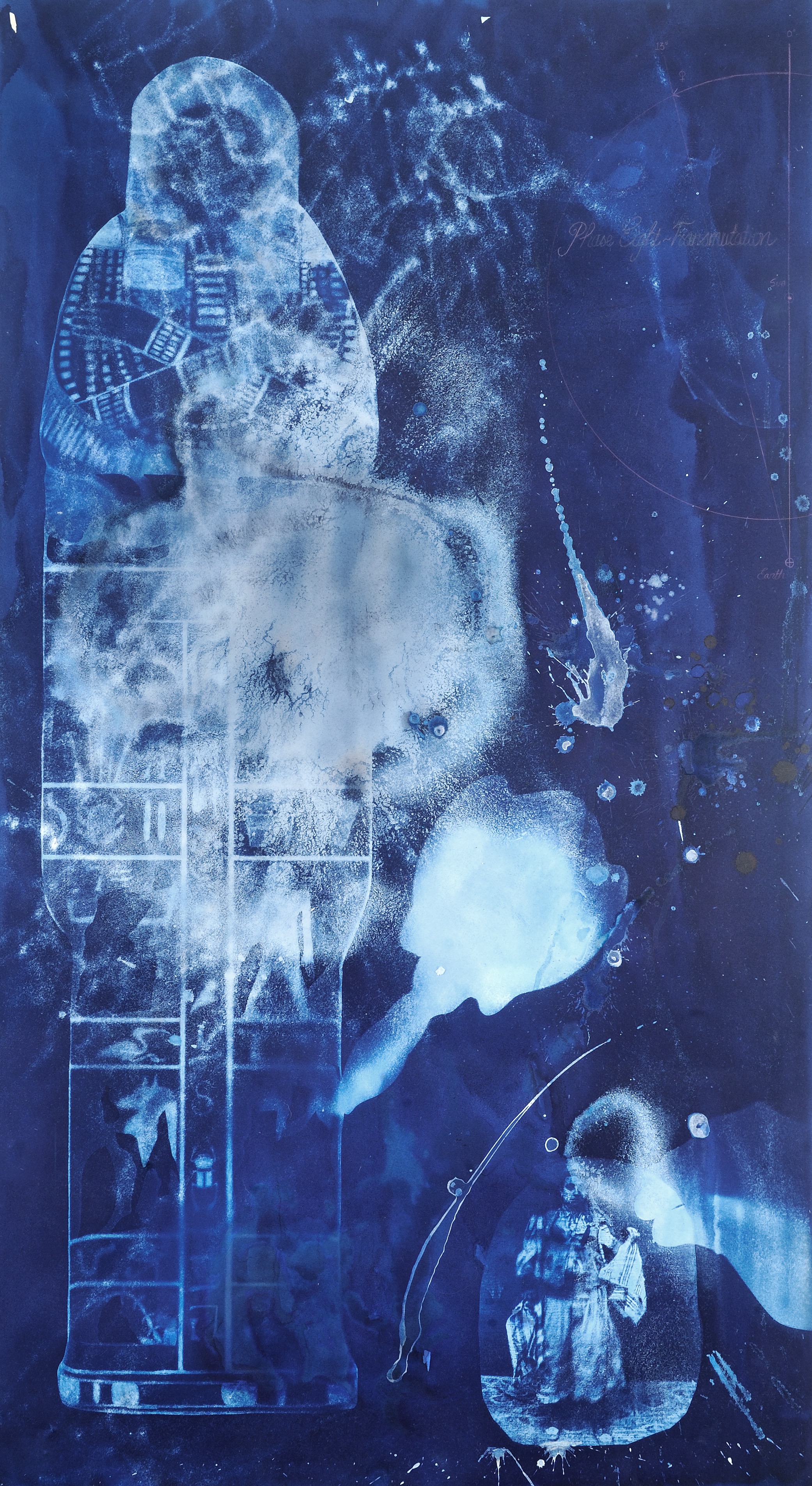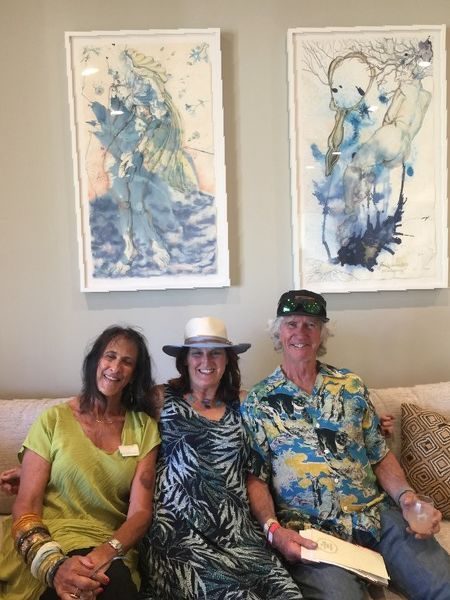
30 Jul Telluride Arts’ Gallery 81435: Klagsbrun Translates “Transit of Venus”
Telluride Arts’ First Thursday Art Walk is a festive celebration of the art scene in downtown Telluride, Participating venues host receptions to introduce new exhibits. August Art Walk takes place Thursday, August 1, 5 – 8 p.m.
Telluride Gallery of Fine Art presents the photographic work of artists, Carl and Caleb Cain Marcus, in an “Altered State.”
Slate Gray Gallery presents “Gone Global,” an exhibit featuring Brazilian-born sculptor, Mozart Guerra, and a fine jewelry collection by the mother-daughter duo, Sloane Street.
MiXX Projects + Atelier features work by Sarah Winkler, Ellen Koment, and Katie Heffelfinger. “Grounded” explores the titular concept from physical, cultural, and geological perspectives across a variety of media
Gallery 81435 presents Micheline Klagsbrun’s latest body of mixed-media work on paper which originated in a found object: a ledger containing observations of the 1874 Transit of Venus, a phenomenon occurring every 243 years when the planet Venus moves across the face of the sun twice. Scroll down for more on that show.
Go to Telluride Arts to read about the work in all of the participating galleries.

Micheline Klagsbrun flanked . by Penelope & Bob Gleason at Telluride Arts’ Art & Architecture event. Two of the works from the Transit of Venus series are pictured.
“Change is the only constant in life,” (Heraclitus).
Multi-media artist Micheline Klagsbrun is a master at capturing and re-imagining a narrative, then translating and transposing it onto a canvas as a luminous work of art. Her paintings and drawings, generally sensuous variations on the theme of mythological subjects, are as much about story as the artist’s obvious technical bravura.
Klagsbrun’s latest body of work, now on display through early September at Telluride Arts’ Gallery 81435, is in keeping with her meta: transformation or change as the only constant in the universe.
In 2017, Telluride Arts featured the artist’s Ovid series, “Remains To Be Seen,” mythological stories interpreted in two- and three-dimensions about desire and punishment, passion and sacrifice, fear and courage, endurance and victory in a world inhabited by nymphs and sirens. For her encore, Klagsbrun’s focus is the goddess of love in a show is titled “Transit of Venus.”

TRANSIT OF VENUS: phase 8: TRANSMUTATION
mixed media with cyanotype on paper
This is a “signature” piece for the exhibit. It clearly shows the artist’s
use of cyanotype to ‘print” her own drawings (Incl. the Ancient Egyptian sarcophagus).

Transit, phase 2, GESTATION. Mixed media with cyanotype on paper.

TRANSIT OF VENUS: phase 4 EMERGENCE.
Ink, color pencil, pastel on paper. This piece has no cyanotype. Botticelli reference to Venus on the clam shell.

MEMORY 2. Cyanotype on paper. One of a few small examples in the show of the artist’s use of cyanotype when she was learning how to work with it. This piece shows a traditional use of cyanotype.
Klagsbrun displayed the same body of work at the Studio Gallery in Washington D.C. Mark Jenkins of the Washington Post was enthralled:
“Taking cues from Greco-Roman mythology, Micheline Klagsbrun often depicts women transforming into trees or flowers. Her new project also focuses on metamorphosis, but the protagonist is a goddess in astral form: Venus, the planet identified as both the morning and evening star. The D.C. artist’s Studio Gallery show, ‘Transit of Venus,’ follows a cycle that beguiled sky-watchers in many ancient cultures.
“Klagsbrun began by consulting a ledger of Venus’s 1874 transit across the sun, adding details from Mayan astronomy, celestial navigation and art history. Seashell forms make reference to Botticelli’s “The Birth of Venus,” in which she stands on a giant scallop. This prompts a possible interpretation of the planet’s cycle as pregnancy and birth. The goddess sometimes appears in human form, as a dancer in the heavens, while an old sailing ship navigates her realm.
“The artist is known for a mixed-media approach that expresses the fluidity of existence. Most of these pictures are cyanotypes (or blueprints) whose ghostly whites on night-sky blues are supplemented by pencil, ink and paint. Liquid gestures suggest milky ways across the universe, while layered images represent creation’s complexity. In Klagsbrun’s world, there’s always more beyond the visible, and something that’s about to change.”
With these new works, Klagsbrun continues her ongoing exploration of the tension between form and formlessness, order and chaos, being and becoming.
“Transit of Venus,” the backstory:
As the goddess of love and light, Venus embodies the feminine principle. At the same time, for Mayans, she could also morph into the goddess of war. As in all’s fair in love and…? In fact, Mayans compiled their observations of the planet in the Dresden Codex, which they used to predict the most auspicious dates for combat.
Online sources describe Transits of Venus as scientific gold for early astronomers, who used them to derive an accurate measurement of the size of the solar system. By noting the time each planet took to go around the sun, then crunching that data via methods developed by 17th century mathematician Johannes Kepler, telescope-equipped boffins were able to determine each planet’s relative distance from the sun, as measured in terms of astronomical units.
The story of Klagsbrun’s “Transit” series begins in a friend’s antique shop:
“I was hanging out chatting when I saw an old musty book lying on the floor. It was an old ledger with ‘Transit of Venus’ stamped in gold on the cover. I was curious. She said she just picked it up in a flea market and didn’t know what to do with it: ‘Take it and do something with it.’ I had no idea what the phrase ‘Transit of Venus’ meant, but I just loved the fact that transit = transition= transformation, which is what my work has always been about. And Venus, of course, the goddess, fit with my other fascination, classical myth.”
When Klagsbrun delved into the history of the Transits of Venus back through the centuries, she came across interesting stories about kings and emperors commanding fleets of ships to sail to distant countries and build observatories just so Venus’ moves could be observed. Turns out Captain Cook’s voyages to New Zealand and Australia resulted from his mission to view the Transit of Venus from Hawaii in 1769.
“I took the Transit of Venus as an entry point for the contemplation of a variety of inter-related phenomena, celestial and astronomical, scientific and mythological,” explains the artist, who used Mayan hieroglyphs, mathematical formulae, diagrams of celestial navigation to create her work.
“Transit of Venus,” from idea to art, the process:
In keeping with the origin of the series, Klagsbrun began many of the pieces with a 19th-century photographic printing technique known as “cyanotype” – cyan being blue – which she used to evoke the indigo-blue depths of cosmos and ocean. Then she took a left turn from the traditional use of this medium both by “printing” her own drawings, rather than solid objects, and then layering the captured images with more drawing in ink and pencil.
“The cyanotype process produces some ghostly effects, mysterious whitish traces that appeal to me. At the same time it essentially plays with light and dark, a theme at the heart of this whole series. Starting from this initial background, I can achieve a complex layering and juxtapositions of different types of mark-making: drawing, splashing with ink, painting and collage. I use layers of texture to convey layers of ideas.”
The sculptural objects:

EYE BOWL
mixed media sculpture with tree root. A large vessel.
Klagsbrun’s sculptural pieces—reminiscent of bowls, vessels, boats—are natural outgrowths of the artist’s paintings and drawings. They are containers or holders fashioned from papier-mâché with added layers of organic elements such as palm leaves, shells, and tree branches. In effect, her sculptural work captures and contains the transformation of the raw materials she finds in nature. Change is manifest, but arrested.
The artist began working in three dimensions in 2015, creating ephemeral objects composed of thin paper layers and drawing fragments that are bound together. These evolved over the past few years into large and small-scale sculptures, many of which incorporate the aforementioned organic elements.

CRADLE. Mixed media sculpture with deer bone .One of the small new sculptures Klagsbrun is currently making using physical remains tied to Telluride and Western Colorado in general.
“I have always relished the exploration of translucency and the layering of textures, and the ways these vessels spill light and shadow took this even further for me. Non-functional in any traditional sense, these objects hold light in dramatic ways. They can even be hung from a ceiling with great effect: one collector in DC hung six of them in his living room where they seem to glow spontaneously,” explained the artist.
Klagsbrun’s latest 3D creations have shifted from vessel-like to more abstract sculptural shapes, incorporating elements of the Colorado landscape, which reflect the fact she is now spending more time in Telluride. The work is imbued with a reverence for the spirits and memories contained in the physical remains, skulls, bones, bark, snakeskin, and other placeholders for place.


Pingback:Gallery 81435, Artist Talk | Telluride Inside... and Out
Posted at 15:31h, 17 August[…] Go here for an in-depth story about Micheline Klagsbrun and her current exhibit at Gallery 81435 […]